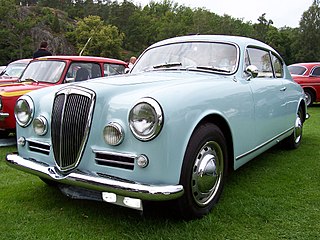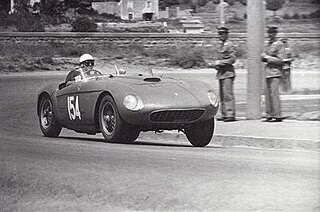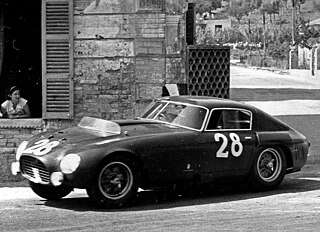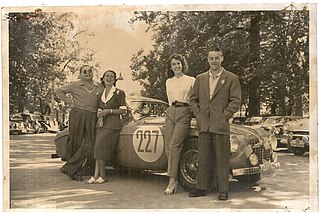
Coppa della Toscana (meaning Tuscany Cup in Italian) was a sports car race held on the roads of Tuscany, through Livorno and Florence, between 1949 and 1954. [1]

Coppa della Toscana (meaning Tuscany Cup in Italian) was a sports car race held on the roads of Tuscany, through Livorno and Florence, between 1949 and 1954. [1]
For the 1949 season of the Mille Miglia race, it was decided that this years edition would bypass the city of Florence. As a direct consequence of this decision, the Automobile Club of Florence decided to organize an alternative race that would run in Tuscany. The new event would enable sports cars and touring cars to compete through the streets of the Tuscan cities and on the roads around the region. [2]
The main organizer of this race was the director of the Florence Automobile Club, Amos Pampaloni who also negotiated with a neighboring automobile clubs to receive their support. In the end the event crossed ten Tuscan provinces: Arezzo, Florence, Grosseto, Livorno, Lucca, Massa, Pisa, Pistoia, Siena and Viterbo.
The race ran from 1949 to 1954 as a non-championship race, circling around the Tuscany region. The first two editions ran on a circuit with a starting point and finish in Livorno, and from 1951 the start and finish was moved to Florence. The distance and course of each race changed with almost every edition, but was much shorter than the Mille Miglia. Contestants had to finish a single lap of the race. [3]
For each race numerous categories were prepared, covering sport, grand touring and touring cars, later expanded by series-produced sports car classes. Each category was further subdivided into engine capacity classes, even as small as 350 cc. [4]


The first edition, I. Coppa della Toscana, was held in July 1949. The start of the race around Tuscany was at Livorno. The course had a total distance of 604 km. Out of 80 teams that entered in the race, only 44 had managed to finish back in Livorno. [5]
The overall winner of the race was Ugo Bormioli in the Ermini 1100 Siluro, that managed an average speed of 113.8 km/h. He competed in a smaller 'Sport 1.1' class. The Lancia Aprilia and Alfa Romeo 6C, on second and third places respectively, were from a bigger 'Sport +1.1' category. [6]
Giovanni Lurani, aided by Cortese won the 'T+1.5' class in a Bristol. Danzi and Bracco in the Lancia Aprilia won the 'T1.5' category. Leonardi/Rosati team in a rare Fiat-Patriarca were first in the 'Sport 750' class. [7]
Top results of the 1949 Coppa della Toscana: [8]
| Pos. | Class Pos. | Class | No. | Drivers | Car |
|---|---|---|---|---|---|
| 1st | 1st | S1.1 | 1210 | | Fiat-Ermini 1100 Siluro [9] |
| 2nd | 1st | S+1.1 | | Lancia Aprilia | |
| 3rd | 2nd | S+1.1 | | Alfa Romeo 6C 2500 | |
| 4th | 2nd | S1.1 | | Stanguellini S1100 | |
| 5th | 3rd | S1.1 | | Stanguellini S1100 |


The second edition, II. Coppa della Toscana, followed a longer circuit route that was 680 km long, with, the start and finish was still in Livorno. Popularity of the race grew and now 152 teams had entered. [10]
Two Ferrari 195 S' scored first two places, the very same cars that placed first and second at the Mille Miglia, earlier that year, but in a reverse order. The winning barchetta's average speed was 127.7 km/h. Third was Ermini only three seconds behind but securing a victory in class. Its Fiat-based engine was half the size of the Ferrari 195. [11]
Schwelm Cruz with Datisi in the Alfa Romeo 6C won the GT class. "Ippocampo" (Umberto Castiglioni) and Mori in the Lancia Aprilia won the 'T+1.1' category. [12]
Top results of the 1950 Coppa della Toscana: [13]
| Pos. | Class Pos. | Class | No. | Drivers | Car |
|---|---|---|---|---|---|
| 1st | 1st | S+2.0 | 1221 | | Ferrari 195 S barchetta [14] |
| 2nd | 2nd | S+2.0 | 1217 | | Ferrari 195 S berlinetta [15] |
| 3rd | 1st | S1.1 | | Fiat-Ermini 1100 |

III. Coppa della Toscana used the same circuit length but the start/finish line was moved to Florence. Even more cars competed this year: 186 and 97 of those were classified at the finish line. [16]

The winning Ferrari 212 Export Fontana Berlinetta l'Uovo was entered by Scuderia Marzotto. [17] The car was converted form a crashed 166 MM barchetta and rebodied in a one-off coachwork by Carrozzeria Fontana. [18] The winner's average speed was 129.7 km/h.
Cornacchia and Del Carlo in the Ferrari 212 MM, entered by Scuderia Guastella won the GT class. [19]
Top results of the 1951 Coppa della Toscana: [20]
| Pos. | Class Pos. | Class | No. | Drivers | Car |
|---|---|---|---|---|---|
| 1st | 1st | S2.0 | 1302 | | Ferrari 212 Export berlinetta [21] |
| 2nd | 1st | S+2.0 | 1258 | | Ferrari 340 America barchetta [22] |
| 3rd | 2nd | S2.0 | | Ferrari 212 Export spyder [23] | |
| 4th | 1st | GT+2.0 | 1303 | | Biondetti Ferrari-Jaguar Special [24] |
| 5th | 1st | S1.1 | 1224 | | Osca MT4 1100 |


Quarta Coppa della Toscana, the fourth edition of the race was held in June 1952. [25] [26] Race distance was lengthened to 739 km. The winning Ferrari's average speed was 121.9 km/h. [27] [28]
Scotti and Pieratelli driving the Lancia Aurelia won the 'GT2.0' class. Felice Bonetto aided by Giampaolo Volpini, also in the Lancia Aurelia, but a B21 berlina, won the 'T+1.5' category. Emilio Giletti with Walter Loro-Piana in the Ferrari 166 MM Touring Barchetta were first in the 'S2.0' class. [29]
Top results of the 1952 Coppa della Toscana: [30]
| Pos. | Class Pos. | Class | No. | Drivers | Car |
|---|---|---|---|---|---|
| 1st | 1st | S+2.0 | 1249 | | Ferrari 225 S berlinetta [31] [32] |
| 2nd | 1st | S1.1 | 1230 | | Osca MT4 1100 |
| 3rd | 2nd | S1.1 | 1210 | | Osca MT4 1100 |
| 4th | 1st | GT+2.0 | | Ferrari 212 MM berlinetta [19] | |
| 5th | 3rd | S1.1 | 1213 | | Osca MT4 1100 |

V. Coppa della Toscana was held in May 1953. Circuit and race distance was shortened to 633 km. In total 200 teams had started the event, 109 of those had classified at the finish line. [33]

Scuderia Lancia dominated the event and podium with all three first places filled by their Aurelia GT 2500. The winning team of Clemente Biondetti and Gino Bronzoni achieved an average speed of 117.6 km/h.

Roberto Sgorbati and Luigi Zanelli, driving the OSCA MT4 1100 won the 'S1.1' class. Luigi Bellucci with Colucci in the Alfa Romeo 1900 won the 'GT2.0' category. Sergio Mantovani and his Maserati A6GCS/53 Fantuzzi Spyder were the 'S2.0' class victors. Carlo Chiti entered the Benedetti Giannini 750 Sport but did not finish the race. [34] Best Ferrari result was tenth overall with Scotti and Cantini. Siro Sbraci driving the Ferrari 212 Inter scored a victory in the 'serS+2.0' category. [35]
Top results of the 1953 Coppa della Toscana: [36]
| Pos. | Class Pos. | Class | No. | Drivers | Car |
|---|---|---|---|---|---|
| 1st | 1st | GT+2.0 | | Lancia Aurelia GT 2500 | |
| 2nd | 2nd | GT+2.0 | | Lancia Aurelia GT 2500 | |
| 3rd | 3rd | GT+2.0 | | Lancia Aurelia GT 2500 | |
| 4th | 1st | S+2.0 | | Gordini T15S 2.3 | |
| 5th | 1st | T+1.5 | | Alfa Romeo 1900 TI | |
| 6th | 2nd | S+2.0 | 933 | | Ferrari 340 MM Vignale Spyder |
| 7th | 1st | S1.1 | 218 | | OSCA MT4 1100 |
| 8th | 1st | GT2.0 | | Alfa Romeo 1900 |

VI. Coppa della Toscana, was the last edition of the Tuscan Cup. It ran on the longest 760 km circuit around the Tuscany. The popularity started to diminish compared to the previous year as only 132 cars were entered. After the race 75 teams were classified. [37]
Race was won by Piero Scotti in a 4.5-litre Ferrari 375 MM Pinin Farina Spyder at an average speed of 126.3 km/h. The second-place 3.0-litre Gordini arrived at the finish line almost twelve minutes later.
Francesco Giardini and Cestelli, driving the Osca MT4 1100 won the 'S1.1' class. Piero Carini with A. Artesani in the Alfa Romeo 1900 TI were first in the 'TS' category. Franco Ribaldi aided by Basili, driving the Lancia Aurelia GT won the 'GT+2.0' class. The smallest engine capacity class, 'S350', was won by the Romiti brothers in the Iso Isetta. [38]
Top results of the 1954 Coppa della Toscana: [39]
| Pos. | Class Pos. | Class | No. | Drivers | Car |
|---|---|---|---|---|---|
| 1st | 1st | S+2.0 | 937 | | Ferrari 375 MM spyder [40] |
| 2nd | 2nd | S+2.0 | | Gordini T24S 3.0 | |
| 3rd | 1st | serS+750 | | Ferrari 250 MM berlinetta [41] | |
| 4th | 3rd | S+2.0 | | Lancia Aurelia GT 2500 | |
| 5th | 2nd | serS+750 | | Maserati A6GCS/53 spyder |
The race ran for six consecutive editions between 1949 and 1954. In 1955 the ten Tuscan automobile clubs failed to come to an agreement over the next years edition. The Automobile Club of Florence was left without support and the Coppa della Toscana was cancelled. The Club decided to organize an alternative Tuscan race on the Mugello Road Circuit, that would later be known as the Grand Prix of Mugello. [42]
In 1996, the members of the Tuscan Vintage Motor Car Club revived the long-closed event. The recreated race became a tourist event called the Tuscan Cup and is recognized by the ASI organisation. Since 2002 the re-enactment of the historical race combined the organizational support of all the Tuscan Automobile Clubs. [43]

Dino was a marque best known for mid-engined, rear-drive sports cars produced by Ferrari from 1957 to 1976. The marque came into existence in late 1956 with a front-engined Formula Two racer powered by a brand new Dino V6 engine. The name Dino was used for some models with engines smaller than 12 cylinders, it was an attempt by the company to offer a relatively low-cost sports car. The Ferrari name remained reserved for its premium V12 and flat-12 models until 1976, when "Dino" was retired in favour of full Ferrari branding.

A grand tourer (GT) is a type of car that is designed for high speed and long-distance driving, due to a combination of performance and luxury attributes. The most common format is a front-engine, rear-wheel-drive two-door coupé with either a two-seat or a 2+2 arrangement. Grand tourers are most often the coupé derivative of luxury saloons or sedans. Many iconic car models, such as the Ferrari 250 GT, Jaguar E-Type, and Aston Martin DB5, are considered classic examples of Gran Turismo cars.

The Ferrari 166 S was a sports racing car built by Ferrari between 1948 and 1953, an evolution of its Colombo V12-powered 125 S racer. It was adapted into a sports car for the street in the form of the 166 Inter.

The Ferrari 159 S (1947) was the second Ferrari vehicle, succeeding the Ferrari 125 S that had won six of 14 races earlier in 1947. Only two 159S were built, one of these rebuilt as a Ferrari 166 Spyder Corsa, and as of 2012, the oldest remaining Ferrari.

The Ferrari 195 S was a sports racing car produced by Ferrari in 1950. It was an improved version of the 166 MM. The 195 S won Mille Miglia, Coppa della Toscana and Giro delle Calabria.

The Ferrari 250 S was a sports racing car produced by Ferrari in 1952. It was the first in the long lineage of Ferrari 250 road and race cars powered by a ubiquitous 3.0-litre Colombo V12 engine. In 1952 the 250 S won the Mille Miglia and 12 Hours of Pescara. At the Le Mans, the same year, it clocked the fastest race lap time. Only a single example was produced.

The Ferrari 225 S was a sports racing car produced by Ferrari in 1952. It was an evolution over the preceding Ferrari 212 Export with important engine upgrades that greatly improved power output. The model was extensively used in competition, winning many international races. The most important include 1952 Monaco Grand Prix for sports cars, Portuguese Grand Prix, Coppa d'Oro di Sicilia, Coppa della Toscana, Coppa d'Oro delle Dolomiti and many others. It was the final Colombo V12 engine iteration before the 250-family stretched it to 3.0-litres capacity.

The Ferrari 212 Export was a sports racing car produced by Ferrari in 1951–1952. The 212 Exports won Tour de France automobile, Giro di Sicilia, Coppa della Toscana, 10 Hours of Messina and other motor races throughout its career. It was meant to be a sports car available for oversea markets.

The Ferrari 375 Plus was a sports racing car produced by Ferrari in 1954. The model competed internationally, winning many major races, including 24 Hours of Le Mans, Carrera Panamericana, 1000km of Buenos Aires, Agadir GP and Silverstone.

The Ferrari 250 Monza was a sports racing car produced by Ferrari in 1954. It was a combination of a stretched chassis and body from the line of inline-four-engined racers with an ubiquitous 3.0-litre Colombo V12 engine.

The Ferrari 375 MM, was a sports racing car produced by Ferrari in 1953 up to 1955 for the road cars. It was named "375" for the unitary displacement of one cylinder in the 4.5 L V12 engine, and the "MM" stood for the Mille Miglia race. In total 26 units were made, including four converted from the 340 MM.

Vittorio Jano designed a new 60° V12 engine for sports car racing for Ferrari. This new engine, introduced in 1956, combined elements of both Colombo and Lampredi engines with new features. Engine architecture was more of Lampredi school but retained smaller Colombo internal measurements. Jano moved to Ferrari along with his designs for the Lancia D50 in 1955 and went on to design not only a new V12 but also a family of the Dino V6 engines soon after. Some of the technical ideas came from the Jano's Lancia V8 DOHC engine, intended for Formula One. This family of engines replaced Lampredi inline-4s known from Ferrari Monza line and went on to win many international races and titles for Ferrari. The design team comprised Jano as well as Vittorio Bellentani, Alberto Massimino, and Andrea Fraschetti.

The Ferrari 275 S was a sports racing car produced by Ferrari in 1950. It was the first Ferrari powered by a new Aurelio Lampredi-designed V12 engine, created as a large displacement alternative to the initial 1,5 L Colombo V12, used in supercharged form in Ferrari 125 F1. Formula One regulations allowed for up to 4.5 L in naturally aspirated form.

The Ferrari 250 MM was a sports racing car produced by Ferrari in 1953. After the initial racing successes of the 3.0-litre Colombo V12 engine, introduced in the 250 S one-off, Ferrari produced a serial racing model. It is best recognisable for the distinctive closed berlinetta bodywork by Pinin Farina. The "MM" in its name stood for the Mille Miglia race.

The Ferrari 376 S was a sports racing car produced by Ferrari in 1955. It was the first raced Ferrari powered by a new Aurelio Lampredi-designed inline-6 engine, created as a larger alternative to the inline-4 series of engines used in the Ferrari Monza race cars. The intention behind the development of this model was the 1955 Mille Miglia race. It was yet another attempt by Ferrari to match the new Mercedes-Benz 300 SLR in competition. All of the created cars were further converted into a bigger capacity models.

The Ferrari 290 S was a sports racing car produced by Ferrari in 1957. It was a development of an earlier 290 MM race car that won the 1956 Mille Miglia. The 290 S was the first sports car manufactured by Ferrari to be powered by a DOHC V12 engine. Its career was very short but it served as an important milestone in the Jano V12-powered lineage.

The Dino 206 S is a sports prototype produced by Ferrari in 1966–1967 under the Dino marque. Ferrari intended to produce at least fifty examples for homologation by the CSI in the Sport 2.0 L Group 4 category. As only 18 were made, the car had to compete in the Prototype 2.0-litre class instead. In spite of this handicap the Dino 206 S took many class wins. The 206 S was the last of the Dino sports racing cars and simultaneously the most produced.

The Ferrari SP was a series of Italian sports prototype racing cars produced by Ferrari during the early 1960s. All featured a rear mid-engine layout, a first for a Ferrari sports car. Major racing accolades include the 1962 European Hill Climb Championship, two overall Targa Florio victories, in 1961 and 1962, and "1962 Coupe des Sports" title.
The 12 Hours of Casablanca was a sports car endurance race organised on the route of the future Ain-Diab Circuit in Morocco. Only two editions were held in 1952 and 1953, before the race was replaced by the Moroccan Grand Prix in Agadir for the 1954 season.

Pierre "Pagnibon" Boncompagni was a French racing driver, best remembered for winning the 1951 Tour de France Automobile.